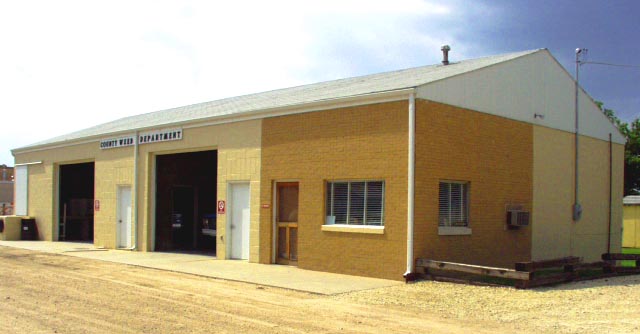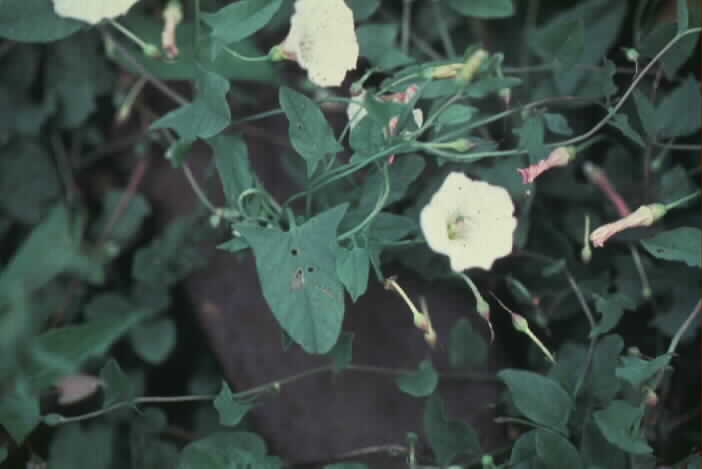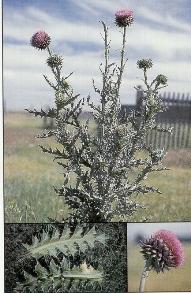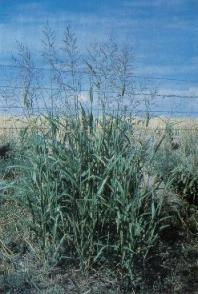Cloud County Noxious Weed Department

Andy Asch, Weed Director
321 Greeley Street
P.O. Box 627
Concordia, KS 66901
Phone: 785-243-4740
Monday - Friday
7:30 a.m. - 12:00 p.m. 1:00 p.m. - 4:30 p.m.
The purpose of this County office is charged with:
- enforcing the State Noxious Weed Law within the County boundaries and
- providing information and material to help control and eradicate noxious weeds
The Kansas Legislature has declared 12 weeds as noxious. They are:
| Musk Thistle | Field Bindweed | Canada Thistle |
| Leafy Spurge | Russian Knapweed | Kudzu |
| Bur Ragweed | Quackgrass | Sericea Lespedeza |
| Pignut | Johnson Grass | Hoary Grass |
The four highlighted weeds are currently infesting Cloud County. Musk thistle, field bindweed, and johnsongrass has been treated in Cloud County for many years. Sericea lespedeza is the “new weed on the block” with land owners showing much concern and interest in controlling it.
The Kansas Noxious Weed Law, KSA, Chapter 2, Article 13, requires all persons who own or supervise land in Kansas to control the spread of and to eradicate all weeds declared by legislative action to be noxious. Copies of the State Weed Law are available at the Noxious Weed Office.
KSA 2-1330 Entry upon and inspection of property. County commissioners, township boards, city officials and state, county and city weed supervisors shall have at all reasonable times, free access to enter upon premises and to inspect property, both real and personal, regardless of location, in connection with the administration of the state weed law.
Chemicals available at the Noxious Weed Office are for the treatment of noxious weeds only. All sales are final. When purchasing chemicals at the weed office, please supply the name of the owner, operator, applicator, legal description of the land, name of weed to be treated, the chemical to be used, the rate per of application per acre, and the amount of acres to be treated.
These chemicals include:
- 2-4-D Amine 4#
- 2-4-D LV ester 4#
- Tordon 22K (Picloram) Restricted Use Chemical. You must have a current Pesticide Applicators Certificate to pick up restricted use chemicals
- Dicamba (Clarity)
- Escort
- Remedy (Sericea lespedeza only)
- Glyphosate (Roundup) (5 gallons available for Johnsongrass unless verification of Johnsongrass infestation by Noxious Weed Office only.) (Not for sale for Field Bindweed, until the month of Ausust (except for special situations, with the discretion of the weed director.)
The current charges for weed treatment on private land in the county are three dollars and twenty five cents ($ 3.25) per acre; this figure is based on ten (10) acres of chemical applied. If less than ten (10) acres of application, the amount will be based on a rate of twenty ($20.00) per hour from time of loading, application time, and arriving back to the weed office.
Kansas Department of Agriculture
Kansas Department of Agriculture Plant Protection and Weed Control Program
Field Bindweed Control Program

DESCRIPTION
Field bindweed, a perennial, reproduces by seeds and rootstocks. The root system is extensive, extending to a depth of 20 to 30 feet. The smooth, slender stems twine or spread over the soil and vegetation. Leaves up to 2 inches long are alternate, simple, petioled, quite variable in size, and highly variable in shape. The leaf blade may be oblong to elliptical or may be rounded to pointed with spreading basal lobes. Flowers are white, pink, or white with pink. Funnel shaped, they are about 1 inch across and usually borne singly in the axils of leaves. The flower stalk has two bracts ½ to 2 inches below the flower; the bracts, along with leaf shape and small flower size distinguish this plant from hedge bindweed. Seeds are dark, brownish-gray, about 1/8 inch long, and have one rounded and two flattened sides.
HOW TO REDUCE NEW BINDWEED INFESTATIONS
Field bindweed is spread both by seed and by roots. New field bindweed infestations result from planting crop seed with bindweed seed or from portions of bindweed roots transported by tillage machinery. Harvesting equipment, manure from livestock fed
contaminated feed, and grazing animals moved from infested to clean areas also cause new bindweed infestations. Seed is carried by birds, on feet of animals, or on wheels of machinery; and seeds or plant parts can be spread by road machinery. Bindweed seed is also carried in drainage water.
Small grain, forage, and legume seed should be cleaned before planting to remove seed of bindweed and other weeds. For livestock feed, one should use grain, hay, and other foodstuffs not infested with bindweed or other weeds difficult to control. If bindweed infested feed is fed to live-stock the manure should not be spread on bindweed free land. Harvesting, tillage, and other machinery should be cleaned before it leaves a bindweed infested field.
CONTROL PRACTICES
Control of field bindweed shall mean preventing the production of viable seed and destroying the plant’s ability to reproduce by vegetative means.
Bindweed seed is viable after remaining dormant in the soil for many years. Seed brought near the soil surface by tillage, rodents, or other means will germinate under favorable conditions, resulting in new bindweed infestations.
Effective field bindweed control can be achieved by applying appropriate control practices. In developing a bindweed control program, one should consider the various alternate control practices and use one or more appropriate control practices for a particular cropland or non-cropland area.
CONTROL PRACTICES FOR CROPLAND
Practices approved for controlling bindweed are: (1) Plant competitive crops, (2) Appropriate and timely cultivation, and (3) application of herbicides registered for use in infested crops or on crop land with no growing crop. Often a combination of control practices results in a more effective program than does a single practice.
Competitive cropping - Close drilled sorghum or Sudan grass seeded about July 1, after a period of intensive cultivation,
provides effective competition for field bindweed. Narrow row grain sorghum may also be used. The effectiveness of all competitive crops depends on intensive cultivation during the bindweed growing season when land is not in crop.
Appropriate and timely cultivation - Intensive cultivation, if properly used, is effective in killing established bindweed. Intensive cultivation alone, however, is not usually practical because no crops can be grown during the cultivation period. Cultivation used with competitive crops can control bindweed. With small grains, the most favorable times for beginning cultivation are in the spring after bindweed growth has started, or in the fall after the grain has been harvested. The depth for cultivation in medium heavy soil is 4 inches. Bindweed cannot be controlled satisfactorily if cultivation is delayed as long as 20 or 28 days after bindweed emergence.
CONTROL PRACTICES FOR NONCROPLAND
Practices approved for controlling bindweed on non-cropland are: (1) hoeing and (2) application of appropriate herbicides.
Hoeing - In non-cropland areas such as home gardens and flower beds and for horticultural or forestry plants, thorough hoeing every 10 days to 2 weeks during the growing season can control bindweed effectively.
It is essential to cut off all plants at each hoeing. Bindweed plants missed in hoeing replenish their reserves, which delays killing time. Results will not be satisfactory if bindweed plants are left outside the hoed area because those plants will supply food to the roots for a distance of about 10 feet, preventing the killing of established bindweed in the hoed area.
HERBICIDES APPROVED FOR CONTROLLING FIELD BINDWEED
The following herbicides may be used for cost-share with landowners. Others labeled for bindweed may be used but not cost-shared. Always follow label instructions and precautions.
2-4-D Amine or LV Ester. Apply during active growth in spring when plant is in bud stage or in fall after 12 inches of new growth.
Clarity (Dicamba). After crop harvest, apply as spot treatment to stubble, fallow or other cropland. Apply during bindweed growth but before killing frost.
Clarity + 2-4-D
Roundup (Glyphosate) Sold for bindweed control during August, September, and October.
Tordon 22k (Picloram) A restricted use herbicide. Use caution if planting a broadleaf crop in the future.
Tordon 22k + 2-4D A restricted use herbicide. Use caution if planting a broadleaf crop in the future.
BIOLOGICAL CONTROL PRACTICES
There are no biological controls approved for field bindweed at this time.
Musk Thistle Control Program
 DESCRIPTION
DESCRIPTION
Musk thistle is primarily a biennial or winter annual but may occur as a summer annual. The leaves of musk thistle are deeply lobed, hairless, and are dark green with a light green mid-rib.
The leaf base extends down the stem to give the plant a winged appearance. Musk thistle is the first of the Kansas thistles to bloom in the Spring. The terminal flower is large (1 ½ to 3 inches in diameter), solitary and usually nodding or bent over slightly. The plant is freely branched and each branch may have one flower or more in addition to the terminal flower. The flowers are purple and are “powder puff” shaped. Seed dispersal begins 7 to 10 days after blooming. Seeds are straw-colored, oblong, and 1/8 inch in length.
The seeds are attached to parachute-like hairs (pappus) which allow for their dispersal by wind currents.
PREVENTION OF SPREAD OF MUSK THISTLE
Musk thistle may be found throughout the State with heaviest infestations found in the north eastern one third of the State.
Musk thistle only reproduces by seed. The likelihood of new infest-ations will be reduced by any action to prevent the production and movement of seed. Planting weed free seed, feeding hay free of musk thistle seed and cleaning equipment before leaving infested areas are methods which will prevent the spread of musk thistle.
MUSK THISTLE CONTROL PRACTICES
The control of musk thistle shall mean preventing the production of viable seed.
CULTURAL CONTROL
Mowing- Mow with a rotary mower between the first appearance of pink and the appearance of brown on the pappus of the earliest heads. Mow cleanly and closely and repeat as needed for control.
Hand cutting - Digging- Cut between the first appearance of pink and the first appearance of brown on the pappus of the earliest head. Dig the root at least two inches below ground level and remove all the soil from the roots.Pick heads that are beyond the bud stage and place in a tight container. Bury the container at a landfill or other site that will not be unearthed.
HERBICIDES APPROVED FOR CONTROLLING MUSK THISTLE
The following herbicides may be used for cost-share with landowners. Other products labeled and registered for use on this noxious weed in Kansas may be used in accordance with label directions but are not available for cost-share. Follow label directions and precautions with all chemicals.
2-4-D Amine or LV Ester. Apply during rosette stage of growth. 2-4-D Amine can be used in the fall if soil moisture is favorable and air temperature exceeds 50 F.
Telar (Chlorsulfuron). Apply in spring from rosette to pre-bloom stages of growth.
Clarity (Dicamba). Apply in spring during rosette stage of growth. Can be used in fall for control if soil moisture is favorable and air temperature exceeds 50 F.
Clarity + 2-4-D (Dicamba + 2-4-D). Apply in spring during rosette stage of growth. Can be used in the fall (see above).
Tordon 22k (Picloram).Restricted use herbicide. Apply during rosette stage in spring or in the fall, prior to soil freeze-up.
Tordon 22k + 2-4-D (Picloram + 2-4-D) Restricted use herbicide. The addition of 1.0 pound of 2-4-D will improve the consistency of musk thistle control with picloram when environmental or biological conditions are not conducive to good herbicidal activity.
Escort (Metsulfuron methyl). Use rates depend on the application site. Consult the label and supplemental labels for directions.
Escort + 2-4-D (Metsulfuron methyl + 2-4-D). Use rates depend on the application site. The addition of 2-4-D will improve consistency of musk thistle control when environmental or biological conditions are not conducive to good herbicidal activity.
BIOLOGICAL CONTROL PLAN
Any biological control plan must meet the requirements of K.A.R. 4-8-41.
Johnson Grass Control Program
 DESCRIPTION
DESCRIPTION
Upright perennial grass, reproduction by large rhizomes and seeds. Well adapted to hold its own in competition with crop plants. Stems up to 6 to 8 feet high or more, from a freely branching, stout, rhizome-possessing, fibrous root system. Leave alternate, simple, relatively wide and long. Spikelets 1-flowered, in groups of three, in rather open large panicles. Fruit a caryopsis or grain, finely striate, reddish-brown. Flowers from May till frost and seed to frost.
PREVENTION OF SPREAD
New infestations of Johnsongrass may be reduced by planting Johnsongrass free seed, using livestock feed that is free of Johnsongrass seed and cleaning machinery before leaving infested fields.
CONTROL PRACTICES
Control of Johnsongrass shall mean preventing the production of viable seed and destroying the plant’s ability to reproduce by vegetative means. Procedures to be used to control Johnsongrass shall include cultural control practices and chemical control or a combination of these two controls.
CULTURAL CONTROL PRACTICES
Cultivation may begin anytime during the growing season and shall be done in such a manner as to cut off all the weed plant at each operation (use duckfoot or blade type implement). Cultivation shall be 3 to 5 inches deep at intervals of 14 to 18 days.
When the plants have been so weakened that they emerge more slowly, the cultivation intervals may be extended to such time as will permit the plants to grow not more than 10 days after each emergence of first plants, but not to exceed intervals of 3 weeks.
Cultivation shall be continued until the weeds have been eradicated or have been suppressed to such extent that remaining plants may be more economically destroyed by the application of approved chemicals to individual plants or by hand cultivation. In yards, flower gardens, lawns and among trees and shrubbery, hoeing and other effective means of thoroughly cutting the weeds at regular intervals of not to exceed 14 days during the growing season shall be construed as intensive cultivation.
A combination of small grains and intensive cultivation may be used. Close grazing or mowing at 2 to 3 week intervals through the growing season and followed by late fall plowing, to expose the root stalks through the winter, is an accepted control practice.
HERBICIDES APPROVED FOR CONTROLLING JOHNSON GRASS
The following herbicides may be used for cost-share with landowners. Other products labeled and registered for use on this noxious weed in Kansas my be used in accordance with label directions but are not available for cost-share. Always read and follow label directions and precautions.
Fusilade (Fluazifop-P-butyl).
Horizon 2000, Fusion (Fluazifop-P-butyl + Fenoxaprop-ethyl)
Plateau (Imazapic).
Roundup
BIOLOGICAL CONTROL PRACTICES
There are no biological controls approved for Johnsongrass control at this time.
Noxious Weed Pages
 |
Andy Asch,
|
The Cloud County Noxious Weed department is tasked with control and eradication of noxious weeds. Select a link below for more information.




